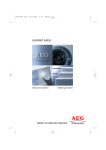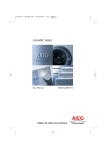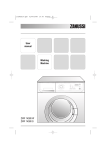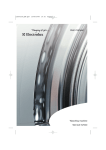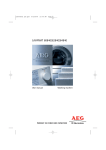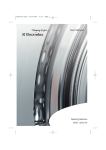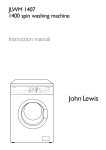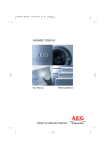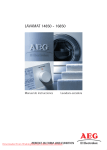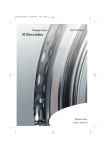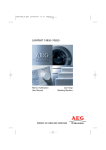Download Electrolux 63742 VI Washer/Dryer User Manual
Transcript
132963770_en.qxd 21/07/2008 8.25 Page 1 LAVAMAT 63742 VI Instruction booklet Washing machine 132963770_en.qxd 21/07/2008 8.25 Page 2 2 Dear Customer Thank you for choosing one of our high-quality products. With this appliance you will experience the perfect combination of functional design and cutting edge technology. Convince yourself that our appliances are engineered to deliver the best performance and control - indeed we are setting the highest standards of excellence. In addition to this you find environmental and energy saving aspects as an integral part of our products. To ensure optimal and regular performance of your appliance please read this instruction manual carefully. It will enable you to navigate all processes perfectly and most efficiently. To refer to this manual any time you need to, we recommend you to keep it in a safe place. And please pass it to any future owner of the appliance. We wish you much joy with your new appliance. The following symbols are used in this manual: Important information concerning your personal safety and information on how to avoid damaging the appliance General information and tips Environmental information 132963770_en.qxd 21/07/2008 8.25 Page 3 Contents 3 Contents Instruction for the user 6 Safety information 6 Product description 9 Detergent dispenser drawer 9 Control panel Display Indicator pilot lights 10 11 12 First use 13 Personalisation 13 Acoustic signals Child safety lock Daily use Load the laundry Measure out the detergent and the fabric softener Select the required programme by means of programme selector dial Select the spin speed reduction or the RINSE HOLD option Programme option button Select the PREWASH option Select the STAIN option Select the SENSITIVE option Select the TIME option Select the START/PAUSE Select the DELAY START Select an additional rinse Altering an option or a running programme Interrupting a programme Cancelling a programme 13 13 14 14 14 15 15 16 16 16 16 17 17 17 18 18 18 19 132963770_en.qxd 4 21/07/2008 8.25 Page 4 Contents Opening the door after the programme has started At the end of the programme 19 19 Washing programmes 20 Programme information 22 Preparing the wash cycle 23 Sorting out the laundry Temperatures Before loading the laundry Maximum loads Laundry weights Removing stains Detergents and additives Quantity of detergent to be used Degrees of water hardness Care and cleaning Descaling After each wash Maintenance wash External cleaning Detergent dispenser drawer Washing drum Door seal Drain pump Water inlet filter Emergency emptying out Frost precautions 23 23 23 24 24 25 25 26 26 27 27 27 27 27 27 28 28 29 30 30 31 What to do if... 32 Technical Data 35 Consumption value 35 132963770_en.qxd 21/07/2008 8.25 Page 5 Contents Installation Unpacking Positioning and levelling Water inlet Water-stop device Water drainage In the interest of the environment Electrical connection Permanent connection Building-in Preparation and assembly of the door Environment concerns Packaging materials Old machine Ecological hints 5 36 36 38 38 39 39 41 41 42 43 43 46 46 46 46 132963770_en.qxd 6 21/07/2008 8.25 Page 6 Safety information Instruction booklet Safety information Prior to using for the first time • The safety of AEG/ELECTROLUX appliances complies with the industry standards and with legal requirements on the safety of appliances. However, as manufacturers, we feel it is our duty to provide the following safety notes. You MUST read them carefully before installing or using the appliance. • It is most important that this instruction book should be retained with the appliance for future reference. Should the appliance be sold or transferred to another owner, or should you move house and leave the appliance, always ensure that the book is supplied with the appliance in order that the new owner can get to know the functioning of the appliance and the relevant warnings. • Before first starting up, check the machine for any damage incurred during transport. Never install a damaged machine. If parts are damaged, contact your supplier. • If the appliance is delivered in the winter months when there are minus temperatures: Store the washing machine at room temperature for 24 hours before using for the first time. General safety • It is dangerous to alter the specifications or attempt to modify this product in any way. • During high temperature wash programmes the door glass may get hot. Do not touch it! • Make sure that small pets do not climb into the drum. To avoid this, please check into the drum before using. • Any objects such as coins, safety pins, nails, screws, stones or any other hard, sharp material can cause extensive damage and must not be placed into the machine. • Only use the advised quantities of fabric softener and detergent. Damage to the fabric can ensue if you over-fill. Refer to the manufacturer’s recommendations of quantities. • Wash small items such as socks, laces, washable belts etc in a washing bag or pillow case as it is possible for such items to slip down between the tub and the inner drum. 132963770_en.qxd 21/07/2008 8.25 Page 7 Safety information 7 • Do not use your washing machine to wash articles with whalebones, material without hems or torn material. • Always unplug the appliance and turn off the water supply after use, cleaning and maintenance. • Under no circumstances should you attempt to repair the machine yourself. Repairs carried out by inexperienced persons may cause injury or serious malfunctioning. Contact your local Service Centre. Always insist on genuine spare parts. Installation • This appliance is designed for domestic use. It must not be used for purposes other than those for which it was designed. • When unpacking the appliance, check that it is not damaged. If in doubt, do not use it and contact the Service Centre. • All packing and transit bolts must be removed before use. Serious damage can occur to the product and to property if this is not adhered to. See relevant section in the user manual. • After having installed the appliance, check that it is not pressing or standing on its electrical supply cable, inlet hose and drain hose. • If the machine is situated on a carpeted floor, please adjust the feet in order to allow air to circulate freely under the appliance. • Always be sure, that there is no water leakage from hoses and their connections after the installation. • If the appliance is installed in a location subject to frost, please read the “ddangers of freezing”chapter. • Any plumbing work required to install this appliance should be carried out by a qualified plumber or competent person. • Any electrical work required to install this appliance should be carried out by a qualified electrician or competent person. 132963770_en.qxd 8 21/07/2008 8.25 Page 8 Safety information Use • This appliance is designed for domestic use. It must not be used for purposes other than those for which it was designed. • Only wash fabrics which are designed to be machine washed. Follow the instructions on each garment label. • Do not overload the appliance. See the relevant section in the user manual. • Before washing, ensure that all pockets are empty and buttons and zips are fastened. Avoid washing frayed or torn articles and treat stains such as paint, ink, rust, and grass before washing. Underwired bras must NOT be machine washed. • Garments which have been in contact with volatile petroleum products should not be machine washed. If volatile cleaning fluids are used, care should be taken to ensure that the fluid is removed from the garment before placing in the machine. • Never pull the power supply cable to remove the plug from the socket; always take hold of the plug itself. • Never use the washing machine if the power supply cable, the control panel, the working surface or the base are damaged so that the inside of the washing machine is accessible. Child Safety • This appliance is not intended for use by person (including children) with reduced physical sensory or mental capabilities or lack of experience and knowledge unless they have been given supervision or instruction concerning use of the appliance by a person responsible for their safety. • The packaging components (e.g. plastic film, polystyrene) can be dangerous to children - danger of suffocation! Keep them out of children’s reach. • Keep all detergents in a safe place out of children’s reach. • Make sure that children or pets do not climb into the drum. To prevent children being trapped inside the drum, the machine incorporates special feature. To activate this device, rotate the button (without pressing it) inside the door clockwise until the groove is horizontal. If necessary use a coin. To disable this device and restore the possibility of closing the door, rotate the button anticlockwise until the groove is vertical. 132963770_en.qxd 21/07/2008 8.25 Page 9 Product description 9 Product description Your new appliance meets all modern requirements for effective treatment of laundry with low water, energy and detergent consumption. 1 2 3 Detergent dispenser drawer Control panel Door opening handle 4 5 6 Rating plate Drain pump Adjustable feet Detergent dispenser drawer Compartment for prewash phase or stain remover . The prewash detergent is added at the beginning of the wash programme. The stain remover is added at the proper time if the STAIN option is selected. Compartment for powder or liquid detergent used for main wash. Compartment for liquid additives (fabric softener, starch). 132963770_en.qxd 21/07/2008 8.25 Page 10 Control panel 10 Control panel 1 2 1 Programme selector dial 2 SPIN button PREWASH button STAIN button SENSITIVE button TIME button Display START/PAUSE button DELAY START button Indicator pilot lights 3 4 5 6 7 8 9 10 3 4 Table of symbols Handwash, Rinse Hold, Child Safety Lock 5 6 7 8 9 10 132963770_en.qxd 21/07/2008 8.25 Page 11 Control panel 11 Display (7) 7.2 7.3 7.1 7.1 Duration of selected programme : After selecting a programme, the duration is displayed in hours and minutes (for example 2.05). The duration is calculated automatically on the basis of the maximum recommended load for each type of fabric. After the programme has started, the time remaining is updated every minute. Alarm codes In the event of operating problems, some alarm codes can be displayed, for example E20 (see chapter «What to do if...»). End of programme When the programme has finished a blinking zero 0 is displayed, the DOOR pilot light (10.2), the WASHING pilot light (10.1) and the pilot light of the button 8 go out and the door can be opened. Incorrect option selection If an option which is not compatible with the set wash programme is selected, the message Err is displayed for about 2 seconds and the yellow pilot light of the button 8 light starts blinking. 7.2 Delay Start (7.2) The selected delay (20 hours max) set by means of the relevant button appears on the display for about 3 seconds, then the duration of the previously selected programme is displayed. The symbol 7.2 will appear on the display. The delay time value decreases by one unit every hour. When only 1 hour remains, the time decreases every minute. 7.3 Child safety lock (7.3) 132963770_en.qxd 12 21/07/2008 8.25 Page 12 Control panel Indicator pilot lights (10) After having pressed the button 8, the WASHING pilot light (10.1) comes on. When the pilot light 10.1 comes on this means that the machine is operating. 10.1 The DOOR pilot light (10.2) indicates if the door can be opened: 10.2 ● light on: the door cannot be opened. 10.3 ● light blinking: the door is opening. ● light off: the door can be opened. When the appliance is performing additional rinses the EXTRA RINSE pilot light (10.3) comes on. To add an additional rinse, please see chapter «Select an additional rinse». If your laundry is not removed during 10 minutes after the programme is finished, the backlight of the display switches off and the energy saving system will be enabled. Only the button 8 pilot light is blinking to indicate that the appliance has to be switched off. By pressing any buttons the appliance will come out from the energy saving status and you could set another washing programme or switch off the appliance. 132963770_en.qxd 21/07/2008 8.25 Page 13 Use 13 First Use Ensure that the electrical and water connections comply with the installation instructions. Remove the polystyrene block and any material from the drum. Run a cotton cycle at 90° or 95°C, without any laundry in the machine, to remove any manufacturing residue from the drum and tub. Pour 1/2 a measure of detergent into the main wash compartment and start the machine. Personalisation Acoustic signals The machine is provided with an acoustic device, which sounds in the following cases: ● at the end of the cycle ● if there is a fault By pressing buttons 3 and 4 simultaneously for about 6 seconds, the acoustic signal is deactivated (except if there is a fault). By pressing these 2 buttons again, the acoustic signal is reactivated. Child safety lock (7.3) This function allows you to leave the appliance unsupervised without having the worry that children might be injured by or cause damage to the appliance. This function remains able also when the washing machine is not working. There are two different ways to set this option: ● before pressing the 8: it will be impossible to start the machine. ● after pressing the 8 it will be impossible to change any other programme or option. To enable (disable) this option press buttons 4 and 5 simultaneously for about 6 seconds until the symbol 7.3 appears (disappears) on (from) the display. 132963770_en.qxd 14 21/07/2008 8.25 Page 14 Use Daily Use Load the laundry 1. Open the door by carefully pulling the door handle outwards. Place the laundry in the drum, one item at a time, shaking them out as much as possible. 2. Close the door firmly. You must hear a click during closing. Attention! Please ensure that laundry items do not get embedded between the door and the rubber gasket. Measure out the detergent and the fabric softener Your new appliance was designed to reduce water, energy and detergent consumption. 1. Pull out the dispenser drawer until it stops. Measure out the amount of detergent required, pour it into the main wash compartment and, if you wish to carry out the prewash phase or to perform the stain function, pour the detergent or the stain remover into the compartment marked . If using liquid detergents, a programme without prewash must be selected. 2. If required, pour fabric softener into the compartment marked (the amount used must not exceed the MAX mark in the drawer). Close the drawer gently. 132963770_en.qxd 21/07/2008 8.25 Page 15 Use 15 Select the required programme by means of programme selector dial (1) The machine is now switched on. You can choose the right programme for any type of laundry following the descriptions on the washing programme tables (see «Washing Programmes»). Turn the programme selector dial to the required programme. The programme selector determines the type of washing cycle (e.g. water level, drum movement, number of rinses) and the washing temperature according to the type of laundry. The pilot light of button 8 starts blinking and the display shows the duration of the selected programme. The selector dial can be turned either clockwise or anticlockwise. Turn to position O to Reset programme/Switch OFF of the machine. At the end of the programme the selector dial must be turned to position O, to switch the machine off. For the description of each washing programmes of the selector dial, see the chapter «Washing programmes». Attention! If you turn the programme selector dial to another programme when the machine is working, the yellow pilot light of button the 8 will blink 3 times and the message Err is displayed to indicate a wrong selection. The machine will not perform the new selected programme. Select the SPIN speed reduction or the RINSE HOLD option (Button 2) When the required programme has been selected, your appliance automatically proposes the maximum spin speed provided for that programme. Press the button 2 repeatedly to change the spin speed, if you want your laundry to be spun at a speed different from the one proposed by the washing machine. The relevant light will light up. RINSE HOLD: by selecting this option the water of the last rinse is not emptied out to prevent the fabrics from creasing. When the programme has finished the display shows a blinking 0, the pilot light 10.2 remains lit, the pilot light of button 8 and the pilot light 10.1 are off and the door is locked to indicate that the water must be emptied out. To empty the water out please read chapter «At the end of the programme». 132963770_en.qxd 16 21/07/2008 8.25 Page 16 Use Programme option button Depending on the programme, different functions can be combined. These must be selected after choosing the desired programme and before depressing the button 8. When these buttons are pressed, the corresponding pilot lights come on. When they are pressed again, the pilot lights go out. If an incorrect option is selected, the integrated yellow pilot light of the button 8 blinks 3 times and the Err message appears on the display for some seconds. For the compatibility among the washing programmes and the options see chapter «Washing Programmes». Select the PREWASH option (Button 3) Select this option if you wish your laundry to be prewashed at 30°C before the main wash. The Prewash ends with a short spin in programmes for cotton and synthetic fabrics, whereas in the programmes for delicate fabrics the water is only drained. The relevant light will light up. Select the STAIN option (Button 4) Select this option to treat heavily soiled or stained laundry with stain remover (extended main wash with time optimised stain action phase). The relevant light will light up. This option is not available with a temperature lower than 40°C and cannot be selected with the PREWASH option. Attention! If you wish to perform a programme with the stain option, pour stain remover into compartment . Select the SENSITIVE option (Button 5) By depressing this button the washing intensity will be reduced. The machine adds one rinse in the programmes for Cotton and Synthetics. This option is recommended for non fast colours and items to be frequently washed. 132963770_en.qxd 21/07/2008 8.25 Page 17 Use 17 Select the TIME option (Button 6) This option allows you to modify the washing time, automatically proposed by the washing machine. DAILY: by pressing this button once, the relative pilot light comes on and the washing duration will be reduced to wash daily soiled laundry. SUPER QUICK: by pressing this button twice, the relative pilot light remains lit, the washing duration will be reduced to wash lightly soiled laundry or items that have been used or worn for a short time. On the display the decreased washing time shows up. Select the START/PAUSE (Button 8) To start the selected programme, press the button 8, the corresponding red pilot light stops blinking. The pilot light 10.1 is on to indicate that the appliance starts operating. The pilot light 10.2 is on to indicate the door is locked. To interrupt a programme which is running, depress the button 8: the corresponding red pilot light starts blinking. To restart the programme from the point at which it was interrupted, press the button 8 again. If you have chosen a delayed start, the machine will begin the countdown. If an incorrect option is selected, the yellow pilot light of the button 8 blinks 3 times the message Err is displayed for about 2 seconds. Select the DELAY START (Button 9) Before you start the programme, if you wish to delay the start, press the button 9 repeatedly, to select the desired delay. The selected delay time value (up to 20 hours) will appear on the display for about 3 seconds, then the duration of the programme will show up again. You must select this option after you have set the programme and before you press the button 8. The wash programme can be delayed from 30 min - 60 min - 90 min, 2 hours and then by 1 hour up to a maximum of 20 hours by means of this button. The door will be locked throughout the delay time. If you wish to add laundry in the machine during the delay time you will press button 8 to put the machine in pause and wait until the pilot light 10.2 goes off before open the door. Add the laundry, close the door and press button 8 again. 132963770_en.qxd 18 21/07/2008 8.25 Page 18 Use Selecting the delayed start. ● Select the programme and the required options. ● Select the delay start. ● Depress button 8: the machine starts its hourly countdown. The programme will start after the selected delay has expired. Cancelling the delayed start ● set the washing machine to PAUSE by pressing the button 8; ● press button 9 once until the symbol 0’ is displayed; ● press the button 8 again to start the programme. Important! ● The selected delay can be changed only after selecting the washing programme again. The button 9 can not be selected with DRAIN programme. Select an additional rinse This appliance is designed for saving water. However, for people with a very delicate skin (allergic to detergents) it may be necessary to rinse the laundry using an extra quantity of water (extra rinse). Press buttons 2 and 3 simultaneously for some seconds: the pilot light 10.3 comes on. This function stays permanently on. To remove it press the same buttons again until the pilot light 10.3 goes off. Altering an option or a running programme It is possible to change some options before the programme carries it out. Before you make any change, you must pause the washing machine by pressing the button 8. Changing a running programme is possible only by resetting it. Turn the programme selector dial to O and then to the new programme position. Start the new programme by pressing the button 8 again. The washing water in the tub will not be emptied out. Interrupting a programme Press button 8 to interrupt a programme which is running, the corresponding light starts blinking. Press the button again to restart the programme. 132963770_en.qxd 21/07/2008 8.25 Page 19 Use 19 Cancelling a programme Turn the selector dial to O to cancel a programme which is running. You can now select a new programme. Opening the door after the programme has started First set the machine to pause by pressing the button 8. If the pilot light 10.2 blinks some minutes and then goes off, the door can be opened. If the DOOR remains locked the pilot light 10.2 is on, this means that the machine is already heating, that the water level is too high. In this case the door can not be opened. If you cannot open the door but you need to open it you have to switch the machine off by turning the selector dial to O. After some minutes the door can be opened (pay attention to the water level and temperature!). After closing the door, it is necessary to select the programme and options again and to press the button 8. At the end of the programme The machine stops automatically, the pilot light of the button 8, the pilot lights 10.1 and 10.2 go off and a blinking 0 will appear on the display. If a programme or an option that ends with water still in the tub has been selected, the pilot light 10.2 illuminates, a blinking 0 will appear on the display, the pilot light of the button 8 goes off and the door remains locked to indicate that the water must be emptied out before opening the door. Follow the below instructions to empty out the water: ● turn the programme selector dial to O ● select the DRAINING or SPINNING programme ● reduce the spin speed if needed, by means of the relevant button ● press button 8 ● when the programme has finished the display shows a blinking 0. The pilot light 10.2 goes off and the door can be opened. Turn the programme selector dial to O to switch the machine off. Remove the laundry from the drum and carefully check that the drum is empty. If you do not intend to carry out another wash, close the water tap. Leave the door open to prevent the formation of mildew and unpleasant smells. 132963770_en.qxd 20 21/07/2008 8.25 Page 20 Washing programmes Washing programmes Programme/ Temperature COTTONS 95°-COLD SYNTHETICS 60°-COLD Type of laundry White and coloured cotton (normally soiled items) Synthetic or mixed fabrics: underwear, coloured garments, non-shrink shirts, blouses Options SPIN, RINSE HOLD, PREWASH, STAIN*, SENSITIVE, TIME**, EXTRA RINSE SPIN, RINSE HOLD, PREWASH, STAIN*, SENSITIVE, TIME**, EXTRA RINSE EASY IRON PLUS Synthetics to be gently washed and spun 40° SPIN, RINSE HOLD, PREWASH, EXTRA RINSE DELICATES 40°-COLD Delicate fabrics: for example curtains SPIN, RINSE HOLD, PREWASH, STAIN*, TIME**, EXTRA RINSE WOOL PLUS HANDWASH 30°-COLD Special programme for hand washing fabrics and special programme for wool garments bearing the «Pure new wool, non-shrink, machine washable» label Note: A single or bulky item may cause imbalance. If the appliance doesn’t perform the final spin phase, add more items, redistribute the load manually and then select the spinning programme SPIN, RINSE HOLD Description of programme Main wash Rinses Long spin Max. load kg 6 ** Red. load kg 3 Main wash Rinses Short spin Max. load kg 3 ** Red. load kg 1,5 Main wash Rinses Short spin Max. load kg 1 Main wash Rinses Short spin Max. load kg 3 ** Red. load kg 1,5 Main wash Rinses Short spin Max. load kg 2 * STAIN option can be selected only at the temperature of 40°C or higher. ** If you select the SUPER QUICK option by means of the TIME button, we reccommend that you reduce the maximum load as indicated. (Red. load = reduced load). Full loading is possible however with somewhat reduced cleaning results. 132963770_en.qxd 21/07/2008 8.25 Page 21 Washing programmes 21 Washing programmes Programme/ Temperature DELICATE RINSES Type of laundry Separate rinse cycle for hand washed items DRAIN For emptying out the last rinse water in programmes with the Rinse Hold option SPIN Separate spin for cotton fabric REFRESH 30° Options SPIN, RINSE HOLD, EXTRA RINSE Description of programme Rinses Short spin Max. load kg 6 Draining of water Max. load kg 6 SPIN Drain and long spin Max. load kg 6 Quick wash for sport items, or cotton and synthetics items lightly soiled or worn once SPIN Main wash Rinses Short spin Max. load kg 3 ECONOMY 60° White and fast coloured cotton economy, lightly-heavy soiled items, shirts, underwear SPIN, RINSE HOLD, STAIN, EXTRA RINSE, SENSITIVE Main wash Rinses Long spin Max. load kg 6 O/OFF For cancelling the programme which is running or to switch the machine off 132963770_en.qxd 22 21/07/2008 8.25 Page 22 Programme information Programme information EASY IRON By selecting this programme the laundry is gently washed and spun to avoid any creasing. In this way ironing is easier. Furthermore the machine will perform additional rinses. WOOL PLUS HANDWASH Washing programme for machine washable wool as well as for hand washable woollens and delicate fabrics with the “hand washing” care symbol . DELICATE RINSES With this programme it is possible to rinse and spin garments which have been washed by hand. The machine performs 3 rinses, followed by a final short spin The spin speed can be reduced by pressing the button 2. DRAIN SPIN REFRESH For emptying out the water of the last rinse in programmes with the RINSE HOLD option. Firstly, turn the programme selector dial to O, then select programme Drain and press the button 8. Separate spin for hand washed cotton garments and after programmes with Rinse Hold option. Before selecting this programme the selector dial must be turned to O. You can choose the speed by means of the relevant button to adapt it to the fabrics to be spun. This programme can be selected with the following options: Spin Speed Reduction and DELAY START. This programme must be used for slightly soiled cotton or synthetics items. ECONOMY This programme can be selected for slightly or normally soiled cotton items. The temperature will decrease and the washing time will be extended. This allows you to obtain a good washing efficiency whilst saving energy. O/OFF To reset a programme and to switch off the machine turn the selector dial to O. A new programme can now be selected. 132963770_en.qxd 21/07/2008 8.25 Page 23 Preparing the wash cycle 23 Preparing the wash cycle Sorting out the laundry Follow the wash code symbols on each garment label and the manufacturer’s washing instructions. Sort the laundry as follows: whites, coloureds, synthetics, delicates, woollens. Temperatures 95° or 90° for normally soiled white cottons and linen (e.g. tea cloths, towels, tablecloths, sheets...). 60°/ 50° for normally soiled, colour fast garments (e.g. shirts, night dresses, pyjamas....) in linen, cotton or synthetic fibres and for lightly soiled white cotton (e.g. underwear). 40°-30°- Cold for delicate items (e.g. net curtains), mixed laundry including synthetic fibres and woollens bearing the label «pure new wool, machine washable, non-shrink». Before loading the laundry Never wash whites and coloureds together. Whites may lose their “whiteness” in the wash. New coloured items may run in the first wash; they should therefore be washed separately the first time. Make sure that no metal objects are left in the laundry (e.g. hair clips, safety pins, pins). Button up pillowcases, close zip fasteners, hooks and poppers. Tie any belts or long tapes. Remove persistent stains before washing. Rub particularly soiled areas with a special detergent or detergent paste. Treat curtains with special care. Remove hooks or tie them up in a bag or net. 132963770_en.qxd 24 21/07/2008 8.25 Page 24 Preparing the wash cycle Maximum loads Recommended loads are indicated in the washing programme charts. General rules: Cotton, linen: drum full but not too tightly packed; Synthetics: drum no more than half full; Delicate fabrics and woollens: drum no more than one third full. Washing a maximum load makes the most efficient use of water and energy. For heavily soiled laundry, reduce the load size. Laundry weights The following weights are indicative: bathrobe napkin quilt cover sheet pillow case tablecloth towelling towel tea cloth night dress ladies’ briefs man’s work shirt man’s shirt man’s pyjamas blouse men’s underpants 1200 g 100 g 700 g 500 g 200 g 250 g 200 g 100 g 200 g 100 g 600 g 200 g 500 g 100 g 100 g 132963770_en.qxd 21/07/2008 8.25 Page 25 Preparing the wash cycle 25 Removing stains Stubborn stains may not be removed by just water and detergent. It is therefore advisable to treat them prior to washing. Blood: treat fresh stains with cold water. For dried stains, soak overnight in water with a special detergent then rub in the soap and water. Oil based paint:: moisten with benzine stain remover, lay the garment on a soft cloth and dab the stain; treat several times. Dried grease stains: moisten with turpentine, lay the garment on a soft surface and dab the stain with the fingertips and a cotton cloth. Rust: oxalic acid dissolved in hot water or a rust removing product used cold. Be careful with rust stains which are not recent since the cellulose structure will have already been damaged and the fabric tends to hole. Mould stains: treat with bleach, rinse well (whites and fast coloureds only). Grass: soap lightly and treat with bleach (whites and fast coloureds only). Ball point pen and glue: moisten with acetone (*), lay the garment on a soft cloth and dab the stain. Lipstick: moisten with acetone as above, then treat stains with methylated spirits. Treat any residual marks with bleach. Red wine: soak in water and detergent, rinse and treat with acetic or citric acid, then rinse. Treat any residual marks with bleach. Ink: depending on the type of ink, moisten the fabric first with acetone (*), then with acetic acid; treat any residual marks on white fabrics with bleach and then rinse thoroughly. Tar stains: first treat with stain remover, methylated spirits or benzine, then rub with detergent paste. (*) do not use acetone on artificial silk. Detergents and additives Good washing results also depend on the choice of detergent and use of the correct quantities to avoid waste and protect the environment. Although biodegradable, detergents contain substances which, in large quantities, can upset the delicate balance of nature. The choice of detergent will depend on the type of fabric (delicates, woollens, cottons, etc.), the colour, washing temperature and degree of soiling. All commonly available washing machine detergents may be used in this appliance: • powder detergents for all types of fabric, 132963770_en.qxd 26 21/07/2008 8.25 Page 26 Preparing the wash cycle • powder detergents for delicate fabrics (60°C max) and woollens, • liquid detergents, preferably for low temperature wash programmes (60°C max) for all types of fabric, or special for woollens only. The detergent and any additives must be placed in the appropriate compartments of the dispenser drawer before starting the wash programme. The washing machine incorporates a recirculation system which allows an optimal use of the concentrated detergent. Pour liquid detergent into the dispenser drawer compartment marked just before starting the programme. Any fabric softener or starching additives must be poured into the compartment marked before starting the wash programme. Follow the product manufacturer’s recommendations on quantities to use and do not exceed the «MAX» mark in the detergent dispenser drawer. Quantity of detergent to be used The type and quantity of detergent will depend on the type of fabric, load size, degree of soiling and hardness of the water used. Follow the product manufacturers’ instructions on quantities to use. Use less detergent if: • you are washing a small load, • the laundry is lightly soiled, • large amounts of foam form during washing. Degrees of water hardness Water hardness is classified in so-called “degrees” of hardness. Information on hardness of the water in your area can be obtained from the relevant water supply company, or from your local authority. Note: A water softener must be added when water has a medium-high degree of hardness (from degree of hardness II). Follow the manufacturer’s instructions. The quantity of detergent can then always be adjusted to degree of hardness I (= soft). Level Characteristic 1 2 3 4 soft medium hard very hard Degrees of water hardness German French °dH °T.H. 0-7 0-15 8-14 16-25 15-21 26-37 > 21 > 37 132963770_en.qxd 21/07/2008 8.25 Page 27 Care and cleaning 27 Care and cleaning You must DISCONNECT the appliance from the electricity supply, before you can carry out any cleaning or maintenance work. Descaling The water we use normally contains lime. It is a good idea to periodically use a water softening powder in the machine. Do this separately from any laundry washing, and according to the softening powder manufacturer's instructions. This will help to prevent the formation of lime deposits. After each wash Leave the door open for a while. This helps to prevent mould and stagnant smells forming inside the appliance. Keeping the door open after a wash will also help to preserve the door seal. Maintenance wash With the use of low temperature washes it is possible to get a build up of residues inside the drum. We recommend that a maintenance wash be performed on a regular basis. To run a maintenance wash: • The drum should be empty of laundry. • Select the hottest cotton wash programme. • Use a normal measure of detergent, must be a powder with biological properties. External cleaning Clean the exterior cabinet of the appliance with soap and water only, and then dry thoroughly. Important: do not use methylated spirits, solvents or similar products to clean the cabinet. Detergent dispenser drawer The detergent dispenser drawer should be cleaned regularly. 1. Remove the detergent dispenser drawer by pressing the catch downwards and by pulling it out. 132963770_en.qxd 28 21/07/2008 8.25 Page 28 Care and cleaning 2. To aid cleaning, the top part of the additive compartment should be removed. 3. Flush it out under a tap, to remove any traces of accumulated powder. 4. Having removed the drawer, use a small brush to clean the recess, ensuring that all washing powder residue is removed from the upper and lower part of the recess. 5. Replace the drawer and run the rinse programme without any clothes in the drum. 6. Having removed the drawer, use a small brush to clean the recess, ensuring that all washing powder residue is removed from the upper and lower part of the recess. 7. Replace the drawer and run the rinse programme without any clothes in the drum. Washing drum Rust deposits in the drum may occur due to rusting foreign bodies in the washing or tap water containing iron. Important! Do not clean the drum with acidic descaling agents, scouring agents containing chlorine or iron or steel wool. 1. Remove any rust deposits on the drum with a cleaning agent for stainless steel. 2. Run a washing cycle without any laundry to clean off any cleaning agent residues. Programme: COTTONS 95° or 90°C, press the button 6, add approx. 1/2 measuring cup of detergent. Door seal Check the door seal from time to time and remove any objects that could be trapped in the fold. 132963770_en.qxd 21/07/2008 8.25 Page 29 Care and cleaning 29 Drain pump The pump should be inspected regularly and particularly if • the machine does not empty and/or spin • the machine makes an unusual noise during draining due to objects such as safety pins, coins etc. blocking the pump. Proceed as follows: 1. Disconnect the appliance. 2. If necessary wait until the water has cooled down. A 3. Place a container close to the pump (A) B to collect any spillage. 4. Release the emergency emptying hose (B), place it in the container and remove its cap. 5. When no more water comes out, unscrew the pump cover and remove it. Always keep a rag nearby to dry up spillage of water when removing the pump. 6. Remove any objects from the pump impeller by rotating it. 7. Replace the cap on the emergency emptying hose and place the latter back in its seat. 8. Screw the pump cover fully in. Warning! When the appliance is in use and depending on the programme selected there can be hot water in the pump. Never remove the pump cover during a wash cycle, always wait until the appliance has finished the cycle, and is empty. When 132963770_en.qxd 30 21/07/2008 8.25 Page 30 Care and cleaning replacing the cover, ensure it is securely retightened so as to stop leaks and young children being able to remove it. Water inlet filter If you notice that the machine is taking longer to fill, check that the filter in the water inlet hose is not blocked. 1. Turn off the water tap. 2. Unscrew the hose from the tap. 3. Clean the filter in the hose with a stiff brush. 4. Screw the hose back onto the tap. Emergency emptying out If the water is not discharged, proceed as follows to empty out the machine: 1. pull out the plug from the power socket; 2. close the water tap; 3. if necessary, wait until the water has cooled down; 4. place a bowl on the floor and place the end of the emergency emptying hose into the bowl. Remove its cap. The water should drain by gravity into the bowl. When the bowl is full, put the cap back on the hose. Empty the bowl. Repeat the procedure until water stops flowing out; 5. clean the pump if necessary as previously described; 6. replace the emergency emptying hose in its seat after having plugged it; 7. refit the pump cover. 132963770_en.qxd 21/07/2008 8.25 Page 31 Care and cleaning 31 Frost precautions If the machine is installed in a place where the temperature could drop below 0°C, proceed as follows: 1. Close the water tap and unscrew the water inlet hose from the tap. 2. Place the end of the emergency emptying hose and that of the inlet hose in a bowl placed on the floor and let water drain out. 3. Screw the water inlet hose back on and reposition the emergency emptying hose after having put the cap on again. By doing this, any water remaining in the machine is removed, avoiding ice forming and consequently damage to the appliance. When you use the machine again, make sure that the ambient temperature is above 0°C. 132963770_en.qxd 32 21/07/2008 8.25 Page 32 What to do if... What to do if... Certain problems are due to lack of simple maintenance or oversights, which can be solved easily without calling out an engineer. Before contacting your local Service Centre, please carry out the checks listed below. During machine operation it is possible that the yellow pilot light of button 8 blinks, one of the following alarm codes appears on the display and at the same time some acoustic signals sound every 20 seconds to indicate that the machine is not working: • E10 : problem with the water supply • E20 : problem with the water draining • E40 : door open. Once the problem has been eliminated, press the button 8 to restart the programme. If after all checks, the problem persists, contact your local Service Centre. Problem Possible cause/Solution The washing machine does not start: The door has not been closed. E40 • Close the door firmly. The plug is not properly inserted in the power socket. • Insert the plug into the power socket. There is no power at the socket. • Please check your domestic electrical installation. The main fuse or the fuse in the plug has blown. • Replace the fuse. The selector dial is not correctly positioned and the button 8 has not been depressed. • Please turn the selector dial and press the button 8 again. The delay start has been selected. • If the laundry are to be washed immediately, cancel the delay start. The CHILD SAFETY LOCK has been activated. • Deactivated this device. The machine does not fill: The water tap is closed. E10 • Open the water tap. The inlet hose is squashed or kinked. E10 • Check the inlet hose connection. The filter in the inlet hose is blocked.E10 • Clean the water inlet hose filter. The door is not properly closed. E40 • Close the door firmly. 132963770_en.qxd 21/07/2008 8.25 Page 33 What to do if... Problem The machine fills then empties immediately: The machine does not empty and/or does not spin: 33 Possible cause/Solution The end of the drain hose is too low. • Refer to relevant paragraph in «water drainage» section. The drain hose is squashed or kinked. E20 • Check the drain hose connection. The drain filter is clogged. E20 • Clean the drain filter. An option / programme that ends with the water still in the tub or a that eliminates all the spinning phases has been selected. • Select the draining or the spinning programme. The laundry is not evenly distributed in the drum. • Redistribute the laundry. There is water on the floor: Too much detergent or unsuitable detergent (creates too much foam) has been used. • Reduce the detergent quantity or use another one. Check whether there are any leaks from one of the inlet hose fittings. It is not always easy to see this as the water runs down the hose; check to see if it is damp. • Check the water inlet hose connection. The drain or inlet hose is damaged. • Replace it with a new one. The cap on the emergency emptying hose has not been replaced or the filter has not been properly screwed in after cleaning action. • Refit the cap on the emergency emptying hose or screw the filter fully in. Unsatisfactory washing results: Too little detergent or unsuitable detergent has been used. • Increase the detergent quantity or use another one. Stubborn stains have not been treated prior to washing. • Use commercial products to treat the stubborn stains. The correct temperature was not selected. • Check if you have selected the correct temperature. Excessive laundry load. • Reduce the amount of laundry. 132963770_en.qxd 34 21/07/2008 8.25 Page 34 What to do if... Problem The door will not open: The machine vibrates or is noisy: Cause possible/Solution The programme is still running. • Wait until the end of washing cycle. The door lock has not been released. • Wait until the pilot light DOOR has gone off. There is water in the drum. • Select drain or spin programme to empty out the water. The transit bolts and packing have not been removed. • Check the correct installation of the appliance. The support feet have not been adjusted • Check the correct levelling of the appliance. The laundry is not evenly distributed in the drum. • Redistribute the laundry. Maybe there is very little laundry in the drum. • Load more laundry. The electronic unbalance detection device has cut in because the laundry is not evenly distributed in the drum. The laundry is redistributed by reverse rotation of the drum. This may happen several times before the unbalance disappears and normal spinning can Spinning starts late or the machine resume. If, after some minutes, the laundry is still not evenly distributed in the drum, the machine will not does not spin: spin. • Redistribute the laundry. The load is too small. • Add more items, redistribute the load manually and then select the spinning programme. No water is visible in the drum: Machines based on modern technology operate very economically using very little water without affecting performance. Mo Pro d. ..... d. No ..... . ..... If you are unable to identify or solve the problem, contact our service centre. Before telephoning, make a note of the model, serial number and purchase date of your machine: the Service Centre will require this information. ..... . Se r. No . ..... .... Mod. .......... Prod. No. ........... P0042 BD Ser. No. ......... 132963770_en.qxd 21/07/2008 8.25 Page 35 Technical data 35 Technical Data Dimensions Width Height Depth (door included) 60 cm 82 cm 54 cm Electrical connection Voltage - Information on the electrical connection is given on the rating Overall power - Fuse plate on the inner edge of the appliance door Water supply pressure Minimum Maximum Maximum Load Cotton Spin Speed Maximum 0,05 MPa 0,80 MPa 6 kg 1400 rpm Water consumption (lltres) Energy consumption (KWh) Programme duration (Hours/Minutes) White Cottons 95° 57 2.1 Cottons 60° 53 1.2 (*)Cotton ECONOMY 60° 42 1.02 Cottons 40° 53 0.7 Synthetics 60° 44 0.9 Delicates 40° 56 0.5 Wool/ Handwash 30° 58 0.25 For the duration of the programmes, please refer to the display on the control panel. Consumption value Programme The consumption data shown on this chart is to be considered purely indicative, as it may vary depending on the quantity and type of laundry, on the inlet water temperature and on the ambient temperature. (*) «Cottons Economy» at 60°C with a load of 6 kg is the reference programme for the data entered in the energy label, in compliance with EEC 92/75 standards. 132963770_en.qxd 36 21/07/2008 8.25 Page 36 Installation Installation Unpacking All transit bolts and packing must be removed before using the appliance. You are advised to keep all transit devices so that they can be refitted if the machine ever has to be transported again. 1. After removing all the packaging, carefully lay machine on it’s back to remove the polystyrene base from the bottom. HEC0008 2. Remove the power supply cable and the draining hose from the hose holders on the rear of the appliance. 3. With the supplied spanner unscrew and remove the central rear bolt A. A 132963770_en.qxd 21/07/2008 8.25 Page 37 Installation 37 4. Unscrew and remove the two large rear bolts B and the six smaller bolts C. C C B D B 5. Remove the bracket D and refit the six smaller bolts C. Slide out the relevant plastic spacer E. E C 6. Open the porthole, take out the inlet hose from the drum. C 7. Fill the smaller upper hole and the two large ones with the corresponding plastic plug caps supplied in the bag containing the instruction booklet. 8. Connect the water inlet hose as described under the paragraph «Water inlet». All the different plug caps are supplied with the appliance in the plastic bag containing the instruction booklet. 132963770_en.qxd 38 21/07/2008 8.25 Page 38 Installation Positioning and levelling Install the machine on a flat hard floor. Make sure that air circulation around the machine is not impeded by carpets, rugs etc. Before placing it on small tiles, apply a rubber coating. Never try to correct any unevenness in the floor by putting pieces of wood, cardboard or similar materials under the machine. If it is impossible to avoid positioning the machine next to a gas cooker or coal-burning stove, an insulating panel covered with aluminium foil on the side facing the cooker or stove, must be inserted between the two appliances. The machine must not be installed in rooms where the temperature can drop below 0. The water inlet hose and the drain hose must not be kinked. Please ensure that when the appliance is installed, it is easily accessible for the engineer in the event of a breakdown. Carefully level by screwing the adjustable feet in or out. After having levelled the machine, tighten the lock nuts. Water inlet An inlet hose is supplied and can be found inside the machine drum. Do not use the hose from your previous machine to connect to the water supply. This appliance must be connected to a cold water supply. 1. Open the porthole and extract the inlet hose. 2. Connect the hose with the angled connection to the machine. Do not place the inlet hose downwards. Angle the hose to the left or right depending on the position of your water tap. 3. Set the hose correctly by loosening the ring nut. After positioning the inlet hose, be sure to tighten the ring nut again to prevent leaks. HEC0006 132963770_en.qxd 21/07/2008 8.25 Page 39 Installation 39 4. Connect the hose to a tap with a 3/4” thread. Always use the hose supplied with the appliance. Installation should comply with local water authority and building regulations requirements. A minimum water pressure of 0.05 MPa is required for safe operation of the appliance. If you cannot make the cold water connection direct from the rising mains, you may be able to operate the appliance from your cold water storage system. There should be a minimum vertical distance of 5.02m (16.5ft) between the appliance’s inlet and the bottom of the water storage tank. Water-stop device The inlet hose is provided with a water stop device, which protects against damage caused by water leaks in the hose which could develop due to natural ageing of the hose. This fault is shown by a red sector in the window “A”. Should this occur, turn the water tap off and refer to your Service Centre to replace the hose. A 352 Water drainage This appliance is designed to be permanently plumbed into your home's drainage system using one of the following methods. 1. Into a drainage standpipe. Firstly form a hook in the end of the drain hose using the “U” piece” supplied. U piece supplied P1199 38 mm (1.5) standpipe diameter 30 cm (12") Place the drain hose into your standpipe, which should have an internal diameter of approximately 38mm thus ensuring there is an air break between the drain hose and standpipe. 132963770_en.qxd 8.25 Page 40 Installation 3 pin Min.60 cm. (23.6") When discharging into a standpipe ensure that the top of the standpipe is no more than 90 cm (35.4'') and no less than 60 cm (23.6'') above floor level. The drain hose may be extended to a maximum of 4 metres. An additional drain hose and joining piece is available from your local Service Force Centre. The joining piece must have an internal diameter of 18 mm. Max. 90 cm. (35.4") 40 21/07/2008 If your drain hose looks like this (see the relevant picture) you do not require the “U” piece”. Just push the hose firmly into the standpipe. 2. Onto a sink outlet spigot. If the outlet spigot has not been used before, remove any blanking plug that may be in place. Push the drain hose onto the spigot and secure with a clip, ensure a loop is formed in the drain hose (see diagram) to prevent waste from the sink entering the washing machine. The drain hose may be extended to a maximum of 4 metres. An additional drain hose and joining piece is available from your local Service Force Centre. The joining piece must have an internal diameter of 18 mm. If you intend to drain the hose from the machine into a sink, make sure that the sink is empty and the plug hole is not blocked. Use the plastic “U -Piece” supplied. Loop 132963770_en.qxd 21/07/2008 8.25 Page 41 Installation 41 In the interest of the environment Washing machines should be connected to the FOUL drainage system, the water will then be taken to a sewage works for treatment before being discharged safely into a river. It is essential that these appliances are not connected to the surface water drainage system as this water is discharged directly into a river or stream and may cause pollution. If you require any further advice please contact your local water authority. SHOWER BATH BIDET WASHING MACHINE DISHWASHER RAINWATER 'RUN-OFF' FOUL DRAIN FOUL SEWERS SURFACE WATER DRAINS & SEWERS SEWAGE TREATMENT WORKS TREATED DISCHARGE RIVER UNTREATED DISCHARGE RIVER Electrical connection SINK TOILET WARNING: THIS APPLIANCE MUST BE EARTHED. The manufacturer does not accept any responsibility for damage or injury through failure to comply with the above safety precaution. If the plug that is fitted to your appliance is not suitable for your socket outlet, it must be cut off and the appropriate plug fitted. Remove the fuse from the cut off plug. The cut off plug should then be disposed of to prevent the hazard of shocks in case it should be plugged into a 13 Amp socket in another part of your home. Green and Yellow - Earth Blue - Neutral Brown - Live GREEN &YELLOW 13AMP FUSE 13 AMP Important The wires in the mains lead are coloured in accordance with the following code: BLUE BROWN CORD CLAMP 132963770_en.qxd 42 21/07/2008 8.25 Page 42 Installation If you fit your own plug, the colours of the wires in the mains lead of your appliance may not correspond with the markings identifying the terminals in your plug, proceed as follows: Connect the green and yellow (earth) wire to the terminal in the plug which is marked with the letter «E» or the earth symbol or coloured green and yellow. Connect the blue (neutral) wire to the terminal in the plug which is marked with the letter «N» or coloured black. Connect the brown (live) wire to the terminal in the plug which is marked with the letter «L» or coloured red. The plug moulded on to the lead incorporates a fuse. For replacement, use a 13 A fuse. Only ASTA or BSI approved fuses should be used. Amp BS1363/A The plug must not be used if the fuse cover/carrier is lost. The cover/carrier is indicated by the coloured insert at the base of the plug. A replacement cover/carrier must be obtained from your local AEG/ELECTROLUX Service Centre. The power supply cable must be easily accessible after installing the machine. Should the appliance power supply cable need to be replaced, this MUST be carried out by a Service Centre. Permanent connection In the case of a permanent connection it is necessary that you install a double pole switch between the appliance and the electricity supply (mains), with a minimum gap of 3 mm between the switch contacts and of a type suitable for the required load in compliance with the current electrical regulations. The switch must not break the yellow and green earth cable at any point. This operation must be performed by a qualified electrician. 132963770_en.qxd 21/07/2008 8.25 Page 43 Installation Building-in 43 600 600 596 in. 600 m 120 416 818 176, 5 515 820 min This appliance has been designed to be built into the kitchen furniture. The recess should have the dimensions shown in picture A. 160 195 541 8 90 0 49 165 A When installing the appliance into the kitchen furniture ensure, if possible, the hoses are placed in either of the two recesses on the back of the appliance. This will help to prevent the hoses from becoming kinked or trapped. Preparation and assembly of the door The machine is originally pre-arranged for the assembly of a door opening from right to left. In this case it is sufficient to screw in the hinges (1) and the counter-magnet (6) provided with the appliance, at the right level (Fig. B). a) Door 6 The dimensions of the door should be: 4 - width 595-598 mm - thickness 16-22 mm 1 The height (C-Fig. C) depends on the height of 2 7 5 1 the adjacent furniture's base. 3 B 23 8 B 35 Ø 12.5-14 depth 16 -22 416 C b) Hinges To mount the hinges it is necessary to drill two holes (dia. 35 mm, depth 12.5-14 mm depending on the depth of door furniture) on the inner side of the door. The distance between the holes hobs fixing centres must be 416 mm. The distance (B) from upper edge of the door to the centre of the hole depends on the adjacent furniture's dimensions. The required dimensions are given in the picture C. The hinges will be fixed to the door by means of screws for wood (2-Fig. B) supplied with the appliance. ,5 C 98 595-5 22+1 132963770_en.qxd 44 21/07/2008 8.25 Page 44 Installation c) Mounting the door Fix the hinges (1) to the machine by means of the M5x15 screws (3-Fig. B). The hinges can be adjusted to compensate for possible uneven thickness of the door. To align the door perfectly it is necessary to loosen the screw (3-Fig. B), adjust the door and tighten the screw again. d) Counter-magnet (6) The appliance is pre-arranged for a magnetic closure of the door. To enable a correct operation of this device, it is necessary to screw the countermagnet (6) (steel disk + rubber ring) into the inner side of the door. Its position must correspond to the magnet (4) on the appliance (see picture D). 6 4 8 D 6 4 If the door has to be opened from left to right, invert the position of the plates (7), the magnet (4) and the plate (5) (Fig. B and E). Mount the countermagnet (6) and the hinges (1) as previously described. 5 7 E 3 1 8 2 Recommendations regarding the construction and fitting of a base when the installation requires an integrated appliance to be raised Where the appliance has been raised by mounting onto a wooden base provided by the installer. The material used to construct the base should have a non slip surface, be water repellent and if possible be one solid piece. If it is not possible to use one solid piece, due to the additional height required, ensure that any additional strips of timber are glued and screwed to the underside of the base (see Fig.F). 600-605 mm 490 mm 95 mm 50 mm Drill four fixing holes see Fig. G G Front edge Top view 132963770_en.qxd 21/07/2008 8.25 Page 45 Installation 45 Position the base into the recess with its front edge as far forward as the adjoining plinth line will allow. The reason for placing the base in this position is to allow a small strip of beading to be fitted in front of the appliance feet. Fix the base firmly to the floor using four appropriate countersunk screws (see Fig. H). Hardwood strip 5 mm x 25 mm 5 X 25 X 605 490 600-605 With the appliance installed adjust all four feet ensuring the machine is stable, and a clearance of approximately 5 mm is left between the top of the machine and the underside of the worktop. H A final check for stability should be carried out with the machine on spin with a load, this will identify the need for any further fine adjustment to the feet. A strip of beading approximately 605 mm W, x 5 mm H, x 25 mm D must be screwed down into the base directly in front of the machine’s feet, this will provide additional security. If required an additional door magnet, part number 1242394-00/3 and disc, part number 1242393-00/5 are available from spare parts. 132963770_en.qxd 46 21/07/2008 8.25 Page 46 Environment concerns Environment concerns Packaging materials The materials marked with the symbol are recyclable. >PE<=polyethylene >PS<=polystyrene >PP<=polypropylene This means that they can be recycled by disposing of them properly in appropriate collection containers. Old machine Use authorised disposal sites for your old appliance. Help to keep your country tidy! The symbol on the product or on its packaging indicates that this product may not be treated as household waste. Instead it should be taken to the appropriate collection point for the recycling of electrical and electronic equipment. By ensuring this product is disposed of correctly, you will help prevent potential negative consequences for the environment and human health, which could otherwise be caused by inappropriate waste handling of this product. For more detailed information about recycling of this product, please contact your local council, your household waste disposal service or the shop where you purchased the product. Ecological hints To save water, energy and to help protect the environment, we recommend that you follow these tips: • Normally soiled laundry may be washed without prewashing in order to save detergent, water and time (the environment is protected too!). • The machine works more economically if it is fully loaded. • With adequate pre-treatment, stains and limited soiling can be removed; the laundry can then be washed at a lower temperature. • Measure out detergent according to the water hardness, the degree of soiling and the quantity of laundry being washed. 132963770_en.qxd 21/07/2008 8.25 Page 47 47 132963770_en.qxd 21/07/2008 8.25 Page 48 www.electrolux.com 132 963 770-01-302008 Subject to change without notice www.aeg-electrolux.co.uk
















































